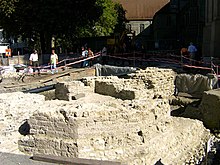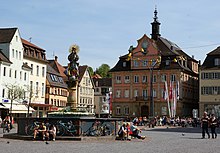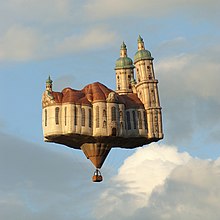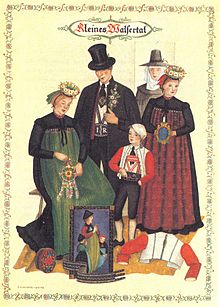"It has been evident for a long time that, of all members of all the Germanic tribes, the Swabian is the most difficult to understand and the most mysterious. In him the most intense contradictions are found. Often, in one individual, meet both extreme boldness and amazing timidity, rebelliousness and philistinism, winning kindness and resentful standoffishness, skillfulness and awkwardness, firmness and instability, mistrust and friendliness, soaring idealism and grounded realisticism."
by Fritz Rahn in Der schwäbische Mensch und seine Mundart (Translation by Matt Carver)
The Swabian (German: Schwaben) cultural region is, for most Austrians, Germans, Swiss and visitors, a very ancient and distinct cultural area, most of which is in Baden-Württemberg, but with a substantial portion also in the western part of Bavaria.
The Vorarlberg of Austria and the northern fringe of Switzerland also used to belong to the Swabian Empire. The whole of Liechtenstein is within the historical confines of Schwaben and the Lech River forms its traditional eastern boundary in Germany.
Understand
editCities
editIn Austria:
- 1 Bregenz - their Vorarlbergisch speech and customs separates the inhabitants of this city from the rest of Austria almost effectively as the Rätikon mountain range. Indeed, after the First World War the people of this area had to be diplomatically restrained by the allied powers from continuing to assert their independence from the rest of Austria for fear of a too diminished Austria being too easily subsumed into a greater Germany - a sentiment that proved all too prescient in 1938!

In the German Customs Area (deutsches Zollgebiet) of Austria:
- 3 Friedrichshafen
- 4 Heidenheim an der Brenz
- 5 Ravensburg

- 6 Reutlingen
- 7 Sigmaringen
- Schwäbisch Gmünd — its population of around 60,000 makes this town the second largest in the Ostalbkreis and it's famous for both its silver and gold handicrafts
- 8 Stuttgart — nicknamed the Schwabenmetropole (Swabian metropolitan centre), because of its location in the very heart of Swabia and also because of the Swabian dialect spoken by its native inhabitants. In that dialect, the city's name is Schtugert or Schtuagerd
- 9 Tübingen

In Bayern:
- 11 Augsburg
- 12 Füssen — the fairy tale castle of Neuschwanstein is nearby
- Harburg
- 13 Kempten
- 14 Landsberg am Lech
- 15 Lindau — the Bavarian port and "island" city on Lake Constance (the Bodensee)
- 16 Memmingen
- 17 Nordlingen

In both Germany and Switzerland:
Other destinations
editUnderstand
editTalk
editSwabian (in standard German: Schwäbisch) is just one, albeit a very major one, of the dialects of German spoken in Swabia. However, like folk from Yorkshire or the Acadian parts of the New World, speakers tend to be rather proud of their linguistic heritage - there is even a tiny, almost stillborn version of Wikipedia in Schwäbisch[dead link] ! If you're interested in Swabian vocabulary and inventions here's an interesting website.
Swabian also used to be spoken by the Volga Germans in the former Soviet Union, part of the Danube Swabian minorities in Hungary, parts of the former Yugoslavia and Romania.
The dialect ranges from a 'standard' Swabian, spoken in Stuttgart, to a variety of more vigorous, denser forms found in its hinterland. Just by listening quietly, many people can often tell the town or area a person comes from.

Like Glaswegian for Britons, Swabian may be difficult to understand for other German speakers, not just because of its distinctive accent and vowel inflections but because it has its very own vocabulary too. For most Germans, a girl is a Mädchen, but when she crosses the Lech she becomes a Mädle. Strawberry jam for most Germans is Erdbeermarmelade while older Swabians often call this preserve Präschtlingsgsälz. Bizarrely, a readers survey of the largest newspaper in Stuttgart, chose as the most beautiful Swabian word: Muggeseggele (the fly's balls) !
Get in
edit
Although this region spreads over several international borders, most travellers will have no bureaucratic hassles, since all the relevant countries are both members of the Schengen agreement on facilitated border formalities and part of the same customs union. Currencies used are the euro (€) and the Swiss/Liechtenstein franc/frank (CHF)
By plane
edit
Stuttgart airport (STR IATA), located in Leinfelden-Echterdingen, hosts various airlines including the low cost airline TUI and has direct flight connections with major German and European cities. It won't be difficult to book a flight to Stuttgart from outside Europe connecting through a major hub such as London Heathrow or Paris Charles de Gaulles. Fares usually don't differ much if at all if you choose to fly into Stuttgart from another continent (rather than to Frankfurt, Munich or Berlin).
Get around
editSee
editDo
editEat
edit
A traditional dish in Swabia is Maultaschen. These are rectangular pasta parcels filled with meat, onions, spinach and various herbs, similar to ravioli but much larger. They can be served "as is" with a little butter or in a broth. Another appetising variant is to slice and fry them in a pan and serve with a seasonal salad. In times of more rigorous religious observance, this was sometimes thought of as a sneaky dish because the diner could plausibly claim that he was abstaining from meat - the offending pork being hidden inside the pasta parcel!

An almost stereotypically Swabian classic dish is Spätzle - egg based noodles often served with a meat dish. A rule of thumb is to use one egg for every diner and then add an extra egg for luck.
Swabians have a reputation for being "Damp Diners (Nass-Esser)" . Most dishes are smothered in a sauce or gravy and a lot of dipping, dunking or crumbling into soups goes on. If you're served a soup, you'll always get a slab of bread to dunk in it if there's not a variety of pasta floating in it already. They're not called "Suppenschwaben" for nothing! Roast meats are invariably served with plenty of gravy.
Drink
editTrollinger grapes make wines that are light to ruby red in colour and were introduced by the Romans. These wines are light and fruity with a nose that has hints of redcurrants and wild cherries. They complement cold sausage (Wurst) platters, poultry and local cheeses, and slide down very nicely on their own!




